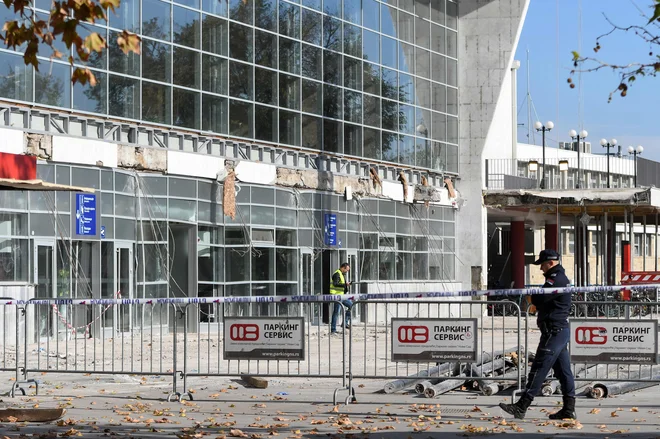
- Sreda, 9. julij 2025
- Delo home
-
Neomejen dostop | že od 14,99€
Is the Tragedy from Novi Sad Possible in Slovenia?

In light of the tragedy caused by the collapse of a concrete canopy at the railway station in Novi Sad, many questions arise, including whether something similar could happen here. As emphasized by civil engineer and president of the main section of civil engineers at the Chamber of Engineers of Slovenia, Andrej Pogačnik, he is surprised that such a structure collapsed so suddenly and completely. Usually, this happens more slowly and over a longer period, and it usually shows signs that something is about to happen.

What and why does this event surprise you?
I do not know this building nor do I know what its structural design is, I only know about the collapse as reported by the media. The canopy was reportedly built in 1964, and generally, such structures or elements can last without major issues for about fifty, sixty years, even more than a hundred years. However, it is true that the station has undergone several renovations and that cantilevers can be very problematic because, in layman's terms, they are anchored to the building at only one point. If that point fails, it falls, which is what happened in this case. I am surprised by such a sudden collapse or such behavior of the structure, as there was no shaking, earthquake, rain, or, as far as is known, wind.
Hypothetically speaking, there are several reasons why such a structure can collapse. One of them could be wear and tear. The building is sixty years old and may have undergone certain changes at some point. Maybe there was some leakage somewhere, corrosion could have started on the reinforcement, or something similar, perhaps this element was not well maintained and collapsed due to wear and tear.
Another reason could be that unprofessional interventions or unprofessional adaptations were carried out on the structure, which were not supported by static calculations.
A third reason could be that the structure was loaded more than prescribed in the static calculation and collapsed. It could have been overloaded at some point in the past, perhaps something was placed on it, causing the initial damage to the structural elements. In any case, such an element of the building should be thoroughly inspected after fifty years, which is its lifespan, and based on that, determine whether any measures need to be taken, or it should be removed and replaced.
After the collapse, a professional inspection is definitely necessary, especially if the canopy was connected to internal elements, as the static loads of the internal elements have been redistributed, and appropriate action should be taken.
It is known that in certain periods in Yugoslavia there was a shortage of building materials, and there were also cases of experimental construction. Could this also be a reason?
It is true that in certain periods in Yugoslavia there was a shortage of building materials and savings were made in this regard, but we can say with certainty that at least as much material was built into the structures as the calculations required.
Which buildings are the most problematic and why?
The older they are, the more problematic they are. The most problematic buildings are those with larger cantilevers and poor maintenance. Moisture is a big problem because it causes corrosion of the reinforcement in the concrete.
How many such potentially dangerous structures are there in Slovenia, in your opinion, and what do you observe in the field during your work? Quite a few railway stations in our country are also awaiting renovation.
It is difficult to assess. Railway buildings in our country are generally well maintained, but there is no guarantee that everything is perfectly safe, as we do not have a register of buildings and parts of buildings to monitor their condition and wear. At the chamber, we strive for Slovenia to adopt a monitoring methodology similar to the one introduced in Cyprus a few years ago, which we learned about at one of the professional meetings.
With it, they thoroughly inspect buildings from all aspects every few years, from earthquake resistance, the load-bearing capacity of individual structural components to all other elements of the building, including the roof, facade, building furniture... We will propose this as the Chamber of Engineers of Slovenia to the competent Ministry of Natural Resources and Spatial Planning.
Cypriot colleagues are ready to present to us in more detail how they introduced this methodology and how they implement it. They also had a hard time convincing decision-makers to accept this as an important and necessary measure. The already developed model of recording with forms, questionnaires, and similar, for which funding would also need to be secured, would need to be adapted to our conditions. But the important thing is that we would start.
In 2018, Italy was shaken by the collapse of the motorway viaduct in Genoa, which claimed 43 lives. How safe are such structures in our country?
The collapse of the Morandi Bridge also happened so quickly, but as it turned out later, it had very worn reinforcement and was poorly maintained. For our infrastructure objects, I can assure you that they are regularly inspected and under constant supervision by the manager, so there are no potentially dangerous objects or errors. Those managed by the state are regularly inspected by Dars and DRSI. Municipal infrastructure, which is under the jurisdiction of municipalities, may be less inspected, as was shown during the floods. Municipal bridges were more damaged than state ones.
The lifespan of buildings is fifty years, for buildings of the highest importance, such as hospitals, it can be longer. But this is not explicitly stated in any legislation. However, regular periodic inspections are necessary, and of course, also after any event that exceeds the calculated load. For example, if a lot of snow falls or if there is a strong wind, the structure needs to be additionally inspected. This is the basic principle after some extreme, catastrophic event, that critical infrastructure, such as hospitals, fire stations, schools, is inspected and, if necessary, repaired.

Probably especially during an earthquake.
Absolutely then. I have talked a lot about earthquake vulnerability. We live in an earthquake-prone area, and an earthquake will surely happen, bringing with it great material damage and casualties. That is why we have been striving for years to do something before it happens, especially not to carry out energy renovations before seismic renovations. Now, with subsidies from the Eco Fund, we are sticking Styrofoam on old, seismically unsafe buildings and renovating facades, which gives people false hope or awareness that they live in a renovated house. In reality, these buildings are not at all earthquake-safe and are a potential threat. That is why we strive for seismic renovation to be carried out before energy renovation or at least simultaneously.
Are you striving to introduce the Cypriot model also because of earthquake safety?
We have been telling the competent ministry for years that an earthquake is a primary danger that we will experience sooner or later, certainly within the lifetime of every individual. The last major earthquake in Ljubljana was in 1895. At that time, about 30,000 people lived in Ljubljana, and there were about twenty victims; now there are about ten times as many residents, and there would be that many more victims. That is why we constantly warn that buildings should be inspected, at least recorded, so we know where problems might arise.
We welcome the fact that a resolution on the earthquake safety of Slovenia has been made, which we have been waiting for a long time, but now it is urgently necessary to make an action plan based on it, which would determine which buildings need to be included in the seismic renovation program. We have many old buildings that are poorly maintained, moreover, they are subject to moisture and various influences, and many people live in them. Many schools are also older than the seismic regulations. Almost all older schools are built seismically unsafe from today's perspective.

What can happen with improper renovation of old buildings?
What happened in Novi Sad. I remember, for example, the collapse in the Ljubljana Kolizej many years ago (there were three fatalities, one person was seriously injured, ed.). This happened because the load-bearing elements were weakened during the renovation. The ceiling elements thus rested on partition walls, and when the partition wall was demolished, the central part of the building collapsed inward. For any renovation, it is necessary to consult an expert on what interventions are needed so as not to undermine the load-bearing capacity of the building.
Where can errors occur in modern construction?
In modern construction, there should generally be no errors, at least as far as structures are concerned, as we have extremely modern regulations in this area. These are the Eurocode standards, which apply to the whole of Europe, and we are fortunate to have adopted standards in the field of building structures that determine loads as well as concrete structures, wooden structures, steel structures, necessary building protection, geotechnical structures, and so on. This is a multitude of standards that greatly contribute to truly safe construction.
What is the lifespan of new building structures, has it extended?
All structures certainly last more than fifty years. Although they need to be periodically inspected, after the end of their lifespan, that is, after fifty years, they need to be more thoroughly inspected. If they are adequate, they can be left for further use, but with regular inspections and maintenance, especially of all those elements that indirectly affect the structure.
As far as the structure is concerned, buildings last longer if they are maintained, but it is true that after 50 years they are also functionally, energetically... outdated. They are poorly insulated, have poor building furniture, and have floor plans or functional designs that are not suitable for the time.
Serbian Opposition with Evidence of Illegal Renovation of Railway Station
The Serbian opposition presented evidence on Thursday that the railway station in Novi Sad, where 14 people died last week in the collapse of the canopy, was built illegally. Protests are also planned in Novi Sad today due to the accident, Serbian media report. STA

Komentarji